Plushie Power: How a Set of Stuffies Is Helping Youngsters in Managing Their Emotions & Aiding Teachers in Preserving SEL Amid a Pandemic
By Gail Cornwall | August 22, 2020
In May 2018, first-graders at George Peabody Elementary School in San Francisco sat cross-legged around the perimeter of a rectangular rug, each slightly swaying and bouncing like an electron held in place by a nucleus’s positive force. It’s hard to say what the main attraction was: Kristine Keane, the school social worker whose eyes narrow in concentration during a child’s tale, or the bowl of colorful stuffed circles she had set in the center of the rug. The little pillows are about the size of a 7-year-old’s palm; they feature a facial expression on one side and, on the other, a word representing an emotion such as “EMBARRASSED.”
“I really like Kimochis,” announced Jerzy Inquito, a blonde with an orange cast. “They help me feel better.”
“Feeling” is, in fact, the translation of the Japanese word (pronounced key-MO-chee) that an executive producer of Despicable Me used for her line of plush toys meant to teach children to better understand and express their feelings. Now, schools are bringing them into classrooms as part of social-emotional learning programs.
It would not be an exaggeration to call Kimochis’ story — complete with a deep-pocketed banker, military ties and a search for truth — one of intrigue.
Full kits include a collection of 28 “feelings” plushies and eight “characters,” larger stuffed creatures that each have their own backstory, temperament, strengths and weaknesses. Cloud, for example, “is a bit unpredictable. One day he is happy, the next he is angry, and the next day — who knows.” Each character has a large pocket into which feelings pillows can be tucked.
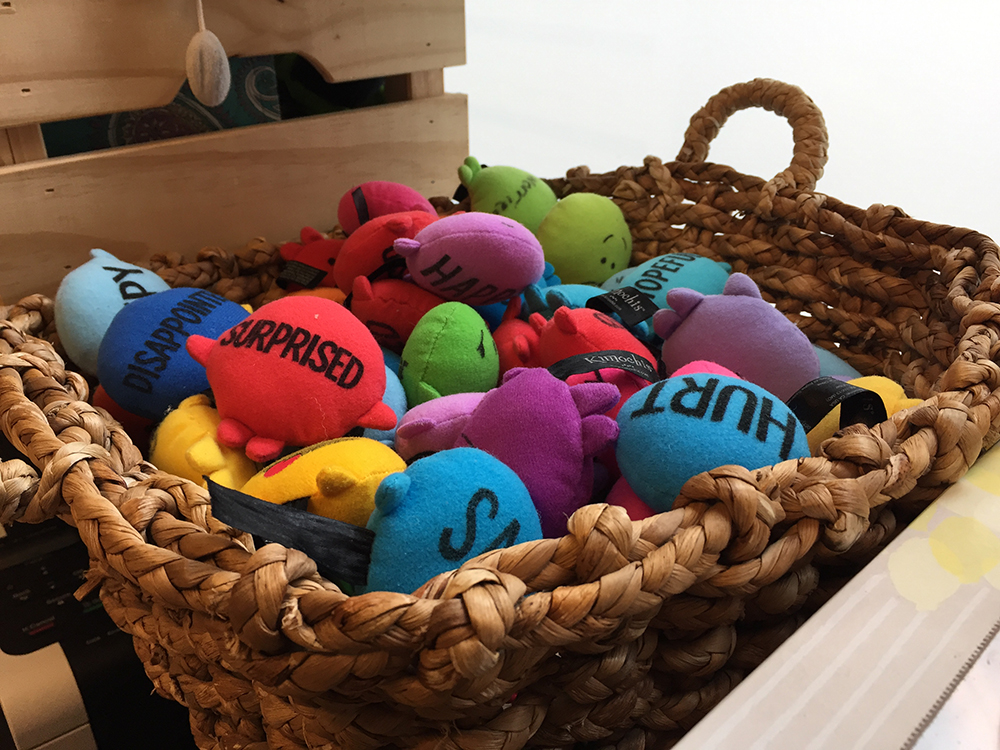
“I have three favorite ones: Cat, Clover and Bug … and Cloud,” Jerzy’s classmate Mason Holley added.
Keane reminded the children of the task at hand: choosing a pillow that matched how they felt about the school year ending.
“I feel sad, because I just like school, and I won’t get to see my friends,” Evan Howard said, as he placed SAD into the bowl and passed it to the left.
“Brave,” shared Rowley Justman, who had plans to visit a dinosaur museum over the summer while harboring a suspicion they might come alive. BRAVE was returned to the bowl.
The students appeared rapt, with the exception of the firm but calm aside Gracie Cunicelli issued her neighbor who’d been pumping his EXCITED-filled fist in the air: “Ben, that’s making me UNCOMFORTABLE.”
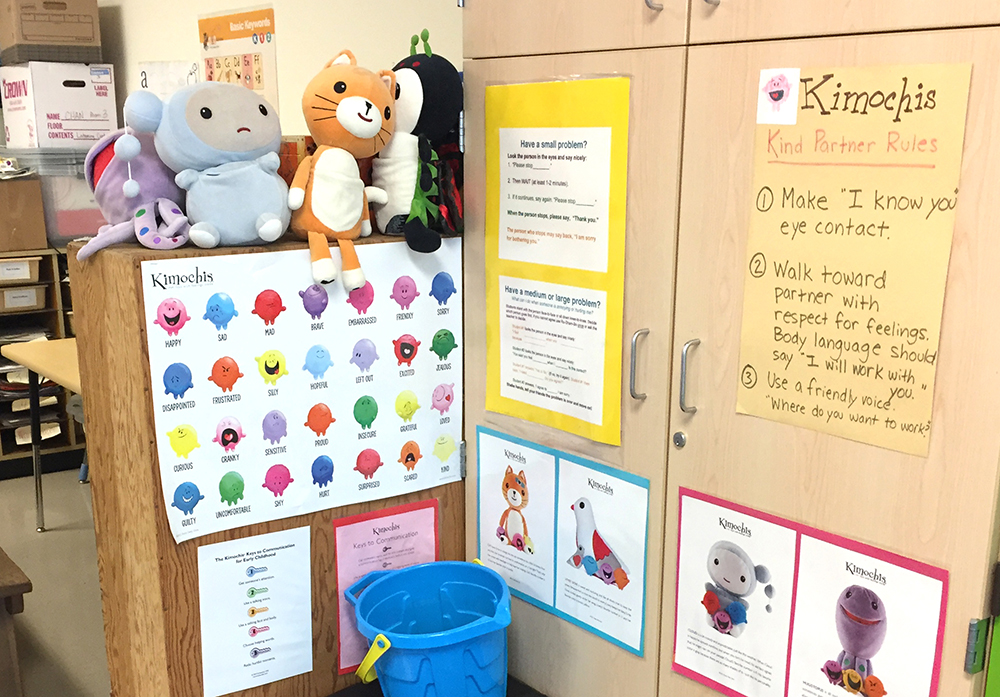
Together, the students inched toward the stuffed animals sitting in front of Keane. After just 20 minutes — though they still held the rectangle formation she’d requested — the shape had shrunk by a foot on all sides.
Now, two years later, as students across the country are learning virtually and losing access to the in-person interactions that are so valuable to developing emotion- and relationship-managing skills, social-emotional learning tools may be more important than ever.
During San Francisco Unified School District’s COVID-19 school closures this spring, Keane dropped into Zoom classes.
“The younger kids lit up to see Bug or Lovey Dove show up in my square,” she said.
But ultimately, she decided the best way to use Kimochis in distance-learning was to create short videos. She covered GRATEFUL, MAD, OPTIMISTIC, BORED, WORRIED, DISAPPOINTED, IMPATIENT and CRANKY. As weeks of quarantine turned into months, Kimochis’ ability to help kids, and their caregivers, process uncomfortable emotions became increasingly important.
“And as we all look ahead to the fall with hope and optimism,” Keane said, “we can also count on the need to address the collective grief and loss in our schools and begin the work of healing. Luckily, Bug will be there, like every first day of school, whether in person or by Zoom.”
Fans of Kimochis believe they have found the holy grail of social-emotional learning, a way to build strong compassionate individuals and community. In a letter to parents, Keane described it as a program, now entering its 10th year at Peabody, “to teach our students, and staff, how to handle feelings and develop empathy.”
But questions linger about how they work and whether the average public school has the resources to implement them effectively.
Are Kimochis ‘the thing’ for social-emotional learning?
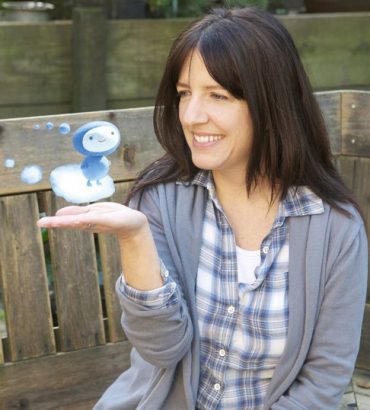
Kimochi toys were developed in 2008 by Nina Rappaport Rowan, the Despicable Me producer, in response to the 1999 Columbine High School massacre. The name for Kimochis, she said, was born out of her love for Japanese design and storytelling.
Wanting children to feel a greater sense of connection, Rappaport Rowan created prototypes and hired Ellen Pritchard Dodge, a speech-language pathologist, to write a curriculum around the toys. Pritchard Dodge structured the program around a list of five competencies — self-awareness, self-management, social awareness, relationship skills and responsible decision-making — developed by the Collaborative for Academic, Social, and Emotional Learning.
“At first I was like, they’re stuffed animals. What are you talking about?” —Kristine Keane, school social worker
About 3,000 schools now use Kimochis, according to the company, including Department of Defense schools on military bases in the United States. Kimochi’s dog character Hero was designed to help military families manage cycles of deployment, but Keane uses him at Peabody too. (“Raise your hand quietly if you have ever had a parent or an auntie or a big brother or a dad or a grandma who goes away, and then they come home, and you want them to play with you but they say, ‘I need a little bit of time,’” Keane asked her students.)
Pritchard Dodge said Kimochis have a heavy presence in Texas, New York, Pennsylvania, California and Illinois. But the plushies can be found across the country. She speaks about them with manic determination: “The thing about Kimochis is, it’s not one more thing. It’s the thing.”
But that’s not always educators’ first reaction.
“At first I was like, they’re stuffed animals. What are you talking about?” Keane said.
Ellen Pritchard Dodge introduces Kimochis’ Cloud character.
The way the feelings pillows normalize emotions, however, “sucked [her] in right away,” Keane said, because in some households only two feelings are allowed: “happy and happier.” That approach, say experts such as famed University of Washington professor John Gottman, author of Raising an Emotionally Intelligent Child, can hold children back in myriad ways. He endorsed Kimochis in part because the feelings pillows take the shame away from negative emotions.
The company says Kimochis are evidence-based because the curriculum was written according to CASEL standards, but Pritchard Dodge admits that the program hasn’t been thoroughly research-evaluated. A couple of case studies, a doctoral dissertation from New Mexico State University, an East Carolina University study with a small sample size and a review of implementation in Fairfax County Public Schools all deemed Kimochis promising and worthy of further study.
In 2019, a team of Stanford researchers led by Professor Jelena Obradović conducted a pilot study in transitional kindergarten classrooms. Though the study was only correlational, not experimental, it’s notable for finding that 100 percent of teacher participants wanted to use the curriculum again. Obradović has designed a more rigorous impact evaluation study and is currently applying for funding.
Keane and Peabody Principal Willem Vroegh also can’t point to substantial quantitative data showing an uptick in student engagement or test scores.
“I’m not going to be Pollyanna about it,” Keane said. “Not every kid reaches for these tools.”
But by all indications, the qualitative benefits of Kimochis are palpable. Bullying, for example, has decreased at Peabody. Still, Keane recognizes that the success Kimochis have found at Peabody isn’t easy to replicate. Schools rarely have a social worker or dedicated staff with time to spare for a program like this.
“A lot of the time, the social worker gets to know the kids who are in the social worker’s office,” she said. “I know every kid’s name. I’m here four days a week. I know not every [social worker] is.”
That, and Keane has been described by her colleagues as “a unicorn.” She created two mommies for the Kimochi character named Bug — to support the child of lesbian parents. When she found out a male student hoped to start wearing dresses to school, she brought Lovey Dove along to read the picture book Jacob’s New Dress.
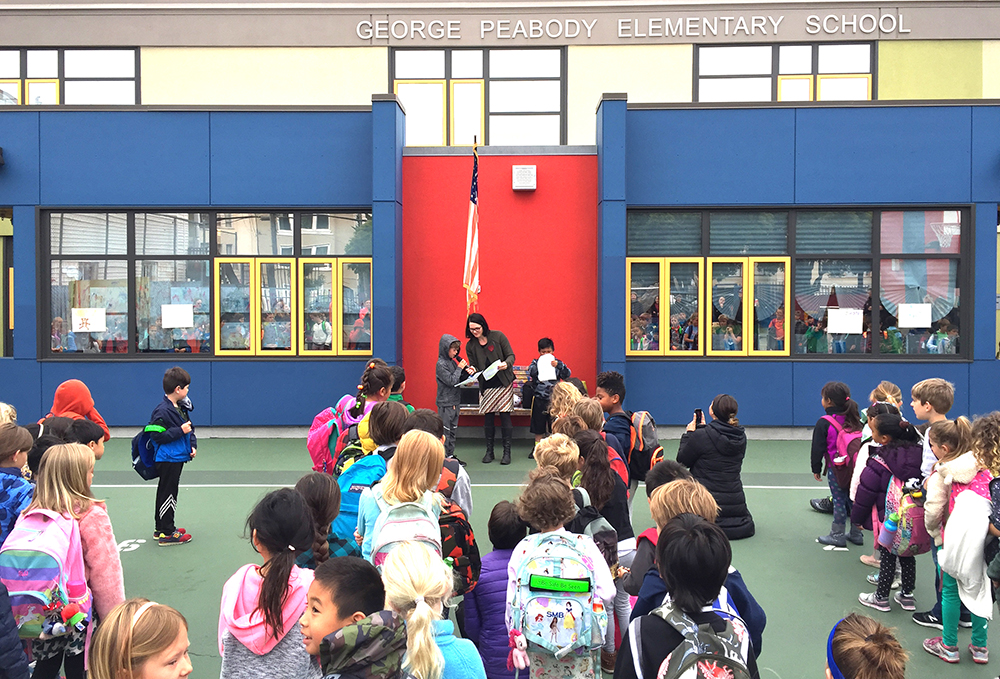
Keane said she followed the Kimochi company’s curriculum at first but then began to improvise to meet the needs of her students — something Pritchard Dodge said is a feature of the Kimochis system, not a bug.
“It’s not a cookie-cutter program,” she said. “It gives the professional or the parent this chicken stock. But you throw in your carrots, your garlic.”
Then there’s the fact that although Peabody is an urban public school, it’s not a particularly underprivileged one — making the feasibility of a program like this more likely than at a school with greater challenges. Peabody’s student body is just 15 percent English learners and 15 percent students with disabilities. There are only 270 students in kindergarten through fifth grade, about 70 percent of whom are white or Asian. Less than a quarter of the student body is reported to be socioeconomically disadvantaged.
Amy Brownstein-Lum taught first grade at Peabody when Kimochis arrived. She said most of its students haven’t experienced trauma. Teacher turnover is exceptionally low.
Giving up academic time to earn more learning time
To be sure, the idea of using anthropomorphized toys in schools isn’t groundbreaking. In 1907, Rudolf Steiner, widely known as the father of Waldorf education, suggested making dolls from old napkins, tied creatively with ink-blot noses and mouths. Sanford Harmony, a different social-emotional learning program, features Z, a plush, bright-green alien. Second Step, another, offers puppets named Puppy and Snail.
Psychologists say there’s something to the unique relatability of the Kimochis characters (like Huggtopus, who “just doesn’t have control over her body,” as Keane put it).
In clinical terms, Kimochis facilitate both externalization and projection. The former, also known as personification, is “a technique for separating emotion from identity by speaking about it as though it were an external entity,” said Lele Diamond, a child development specialist at Symbio in San Francisco.
Saying that “anger made me use those words,” for example, can feel safer than “I’m angry.”
Projection is a healthy version of the Freudian concept, Diamond said, allowing kids to resolve their issues by discussing them in the context of a third party.
“It’s harder for a little 6- or 7-year-old to say, ‘I feel embarrassed about how I acted,’ but we can talk about Cloud being embarrassed because Cloud just rained on his friend,” Keane said.
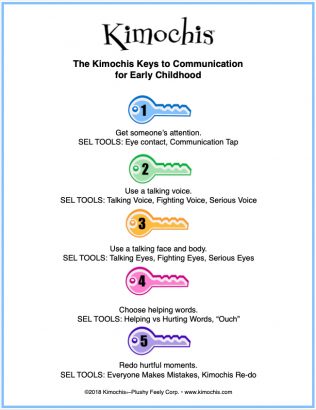
Finally, there’s the curriculum, with lessons reinforcing seven practical, positively phrased behavioral directives that sound and work a little like a politician’s talking points. These “keys to communication” range from “Use a talking voice” to “Forgive and let people try again.” It also incorporates 13 kotowazas — the term means “proverbs” in Japanese but is used in the context of Kimochis to signify “wise sayings” linked to different emotions. A favorite is: “For silly to be fun, it has to be fun for everyone.”
Social-emotional learning is one of those education buzzwords that means different things to different people. Some use the term to refer to acquiring “character strengths” like perseverance and grit, as opposed to academic knowledge-building.
But a January 2018 report from the Aspen Institute said this kind of thinking can create a false dichotomy between emotions and academic development, which “are deeply intertwined.”
“Reviews of several hundred experiment-control group studies indicate that social-emotional learning programs positively affect student outcomes” not just in the expected domains — social and emotional skills, attitudes toward self and others, positive social behavior, conduct problems and emotional distress — but when it comes to academic performance as well, said Roger Weissberg, a professor emeritus at the University of Illinois at Chicago.
Social-emotional learning, he said, can even “be integrated to enhance academic instruction in certain areas. For example, empathy-building may facilitate character analysis in literature classes.”
Allison Lee, a fifth-grader in 2018, saw that happen at Peabody when her class was reading the novel Feathers and they used Kimochis to talk about “their feelings and how they might feel and the perspective of the characters.”
Recent research has even shown that boosting social-emotional skills has a greater impact on student success than boosting test scores. That could, at least in part, owe to a point made by Linda Darling-Hammond, a Stanford professor turned president of the California State Board of Education, at a February 2020 education journalists’ event: that investing 20 minutes or so a day in teaching kids how to regulate their emotions and resolve conflict can actually free up more minutes for instruction.
With the recent heightened focus on social-emotional learning, many districts have worked to build programs to support it, including hiring dedicated directors. A representative for the SFUSD said there is no official count on how many of its schools are using Kimochis, but Peabody isn’t the only one. They’ve been introduced at Dianne Feinstein Elementary School, Ulloa Elementary School and Rooftop Elementary School as well. And the Early Education Department placed an order of kits in May 2020 for all of the district’s 22 transitional kindergarten classrooms.
‘Feelings fuel behaviors’
A necessary precondition for the success of any social-emotional program, however, is that it permeates a school, changing its culture, said Ron Berger, chief academic officer of the nonprofit EL Education. Social-emotional learning “is not about buying a program that you do on Tuesday afternoons,” he added.
That’s clear from observing Keane. Bustling about the school, she has the look of a sherpa, her hands perpetually full of stuffed animals and feelings pillows, a poster with the keys and kotowazas printed on it, an oversize bowl and a shovel (for stirring “feelings soup,” naturally).
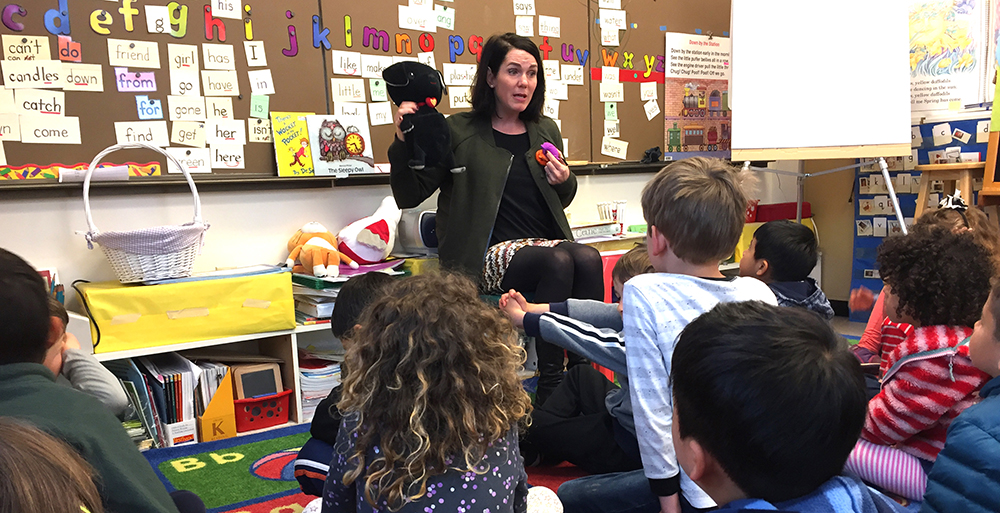
In times outside of COVID-19, she runs a whole-school Kimochis presentation on Monday mornings. She teaches a kindergarten lesson every two weeks and in each first- through third-grade class once a month. She uses the materials in her one-on-one sessions, and every fall Keane teaches parents a seminar titled “Kimochis 1.0,” sometimes in Spanish. Her monthly newsletters include Kimochis updates. Each classroom has its own kit of characters and feelings in a “Kimochis corner.” The library lends out Kimochis picture books.
“It’s been great that it’s been embraced by the teachers and the community, and the language is spoken throughout the day and the kids know it, the teachers know it,” Principal Vroegh said in 2018. Throughout coronavirus closures this spring, he sent weekly emails sharing the Kimochis videos with the community.
Though Keane acknowledges varying levels of training and degrees of buy-in among staff, every teacher — as well as every instructor in Peabody’s afterschool program — has been trained, most of them via six hours of formal professional development from Pritchard Dodge in her role as educational director for Kimochis.
Not every Peabody educator uses Kimochis as the primary tool for classroom management, Vroegh admitted, but “from class to class it still gets used so [students] don’t have to every year learn a different system.”
“It helps the school be a more friendly, calm environment. If kids can handle their concerns and their problems [from recess] with one another first, then it’s not getting back into the classroom.” —Principal Willem Vroegh
When students are sent to the office, things go differently than they used to, “shifting the focus from discipline to connection,” Pritchard Dodge said. With the adults on hand steeped in the mantra “Feelings fuel behaviors,” children are asked to pick out the feelings pillows needed to tell the story of what happened, Keane said.
“They might start with, ‘I was HAPPY. We were playing four square. And then I felt LEFT OUT because he said I stepped over the line, and I didn’t. Then I felt MAD, because he pushed me out of the square, and now I’m feeling SAD because I’m up here in trouble,’” she said.
Often, the interaction ends with a previously recalcitrant child reaching into the bowl for SORRY. Using this process, and the shorthand reminders for regulating tone and body language, she noted, makes for more effective restorative justice circles, too.
Affirming Darling-Hammond’s point that greater student competency in emotional self-management buys more time to focus on academics, Principal Vroegh reported perceiving a big boost in readiness to learn and reclaimed instructional minutes thanks to Kimochis.
“It helps the school be a more friendly, calm environment,” he said. “If kids can handle their concerns and their problems [from recess] with one another first, then it’s not getting back into the classroom.”
When it does, teachers can teach while students work out their differences independently in the Kimochis corner. Keane said individual focus is also increased by giving kids tools to recognize and manage unpleasant emotions.
“It can really free up some of the worry and nervous energy that might be spent otherwise thinking about ‘Mom is traveling’ or ‘my friend is mad at me,’” she said.
For Brownstein-Lum, the first-grade teacher, Kimochis weren’t treated as a separate learning unit — they were integrated into the fabric of each day.
One of her colleagues chose to do a daily Kimochis mini-lesson after lunch. In that classroom, it reportedly got to the point that when a child was pushed and began to cry, another wordlessly went to the Kimochis corner, got Lovey Dove, the character that specializes in acceptance and compassion, and handed it to them.
Brownstein-Lum said when Keane came to her class, she took part along with the kids.
“The teacher being involved in the lesson is a huge piece,” Brownstein-Lum said.
That’s both because it enables reinforcement of the lesson later and because the kids see the buy-in, Keane said, “so it’s not just, ‘Ms. Keane teaches Kimochis — this is only important when Ms. Keane is here.’”
‘The kids are teaching’ the teachers
Successful whole-school implementation of a program is traditionally so elusive that it’s hard to believe the rosy picture the adults at Peabody paint. Sure enough, in one third-grade classroom, the Kimochis corner sat near the ceiling, the characters having been stuffed atop a bookshelf far too high to allow for regular use.
But kids spontaneously and consistently backed up the staff’s assertions.
“If you go to a teacher and say, ‘Someone hurt my feelings,’ they’ll be like, ‘Use the Kimochis,’” said Raya Gottesfeld, a fifth-grader in 2018. She told the story of a new recess coach arriving at the school, laughing as she recounted, “He was like, ‘I still don’t know how to say them, like, Emojis?’” With a shrug, she said, “The kids are teaching him and stuff.”
And whenever Violet Wolfe, a third-grader that May, had a conflict with friends, she used her “V of choice,” she said.
It’s a visual cue that Keane taught them. Hold up the pointer and middle fingers of one hand in a V. The top of that V is wide and the bottom is narrow — one choice will make a problem smaller, while another will just expand negative feelings. Violet explained it using the example of a game of wall-ball.
“If I think someone is out, and they don’t think they’re out, then instead of making a bad choice, like just shouting, ‘They’re out and you know it!’ I say, ‘Can we roshambo to see if they’re out or not?’” she said.
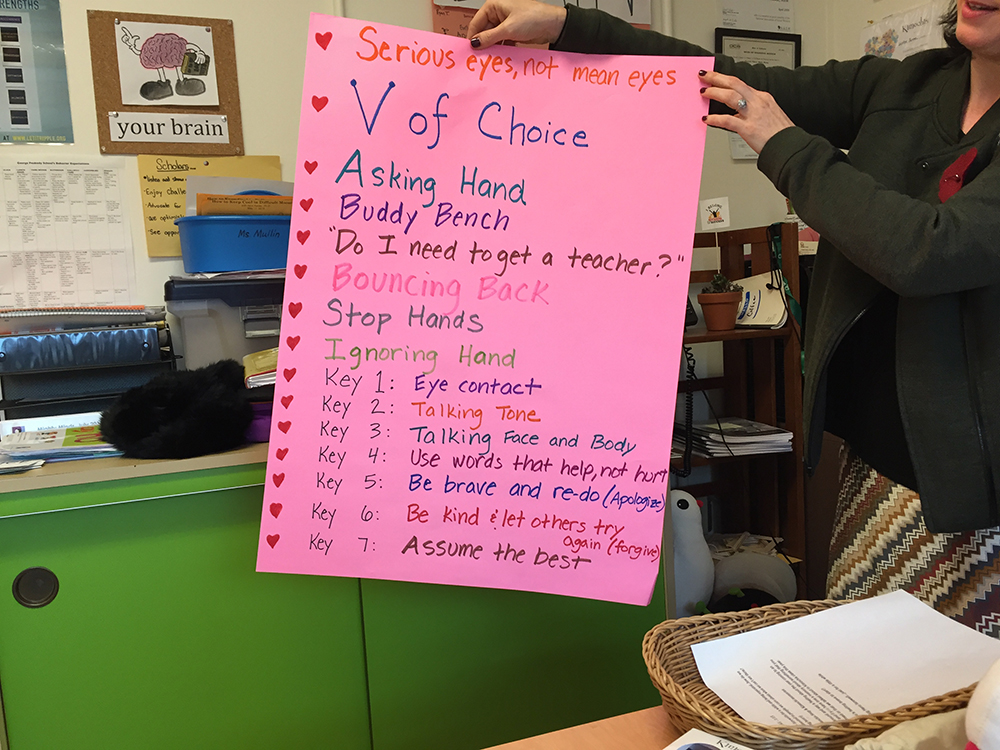
Peabody students use the “V of choice” as well as “bouncing back,” a strategy they learned from Kimochis character Clover, said Piper Johnson, also a third-grader at the time. (“Clover might sleep late, miss the bus, or forget your birthday,” the Kimochis website reads, “but Clover always finds a way to pick himself up again.”)
Both Violet and Piper said these and other Kimochis techniques helped them avoid distraction in class, and there’s a noticeable difference between playing with friends from school — who are well versed in those techniques — and those around the neighborhood who have not experienced Kimochis.
Their classmate Willow Pound didn’t seem as enthused, suggesting that her peers overuse the phrase “Do I need to get a teacher?” But without it, she said, “there would be a lot more conflict.”
Peabody parents would seem to agree. Karin Little, a parent member of the school’s site council in 2018, said the feedback from parents has been very positive. She saw the change in how her own son communicates, and she’s certainly not worried about Kimochis having displaced learning time.
“In fact, I’m wanting more of it in middle school!” Little said.
Parent Kate Kim originally saw the Kimochis characters as just “cute,” but she started using them at home to improve parent-child relations after her kindergarten son said, “Ms. Keane told me it’s OK to be mad, because Cloud gets mad all the time, but it’s not OK to be mean.”
Kim borrows them from the lending library in Keane’s office — made possible by parents who have donated their home collections upon their children aging out.
“I was really surprised that a public school has this kind of emotional-related system,” she said. “I think if other schools could have this, that would be so beneficial.”
A series of fortunate events
To be sure, the fortuitous story of how Kimochis came to Peabody highlights the caveats about the program’s success at this particular school. In 2009, Peabody’s school counselor was a woman named Maryellen Mullin. (She later founded and now works full time at San Francisco Family Therapy.) Back then, a friend of Mullin’s was part of a 25-school national pilot program Kimochis did.
“She kept saying, ‘Oh, we have this great new SEL program,’ and you know, you are sort of like, ‘I have trained in 20 of them. I really don’t care about your new SEL program,’” she said.
Mullin eventually gave in and went to see Pritchard Dodge teach a lesson.
“I thought, ‘Whoa, there is something really different about this,’” she said, but cut straight to the bottom line: “How much money is this going to cost me?”
One kit of the variety that Peabody now has in every classroom ran just under $500 at the time. Mullin mentioned the program to Angelique and Troy Griepp, the parents of a girl she had babysat while in graduate school. Troy happened to help manage billions for Morgan Stanley, and the two had a family foundation. They cut a personal check for Mullin to buy the first set of Kimochis for Peabody.
In the spring of 2010, three classroom teachers, including Brownstein-Lum, agreed to beta test the program for one semester. When they circled back with positive testimonials, Mullin pitched schoolwide implementation to the leadership team. Vroegh gave the project his full support, and Mullin jokingly asked the Griepps if they would consider increasing their initial investment 10 times over. They obliged, covering the cost of a kit for every classroom and for Pritchard Dodge to provide on-site training in August 2011.
The challenge of any social-emotional learning program, Mullin said, is that “most teachers are too spent to do other things and then it never gets a grip.”
So she went to every classroom every week, and only the fourth- and fifth-grade teachers pushed back.
“The teachers that were using it were getting somewhere,” she said. “And then the teachers who weren’t using it and just relying on me were still getting somewhere.”
For schools that can afford it, the company offers a variety of in-person and virtual training options. As of February 2020, Pritchard Dodge said educators could go to Marin, California, for a one-day intensive training for $300 per person, hire an implementation trainer for an on-site visit for $3,500 plus travel expenses, schedule a customized virtual training for $1,700 for as many staff members as can view the screen, or take a paced (once every four to six weeks) or self-paced video course for $1,700.
That said, anyone who purchases a kit, including even a single educator at a school, receives a free one-on-one consultation and has access to an online portal with free downloadable tools. And any school that implements Kimochis schoolwide receives a customized virtual training free of charge.
“We are trying to figure out more ways to serve the underserved,” Pritchard Dodge said. “We don’t feel like we have done that well yet.”
‘A game-changer’ for boys
As excited as she is that SFUSD will be expanding the program, Keane has one complaint about Kimochi characters: they have genders. Cat, for example, is a girl, and her description reads, “She loves to be in charge but can sometimes be a bit bossy.”
Pritchard Dodge — who has collaborated with William Pollack, an associate professor of psychology at Harvard Medical School and the author of Real Boys — thinks this design flaw gives educators a chance to model critical thinking.
“I tell classroom teachers, the kids will read the story, and it will say ‘he’ or ‘she,’” Pritchard Dodge said. “But that’s a natural place to say, ‘You know, Cat could be a girl or a boy. The inventor decided to do it that way. What do we think about that?’”
As the 2018 school year drew to a close, Keane gathered with Mullin and Pritchard Dodge in her office at Peabody. Keane mentioned how much kids miss Kimochis after they age out of the program, particularly boys. She said her male students get few opportunities to engage with emotions other than the one commonly accepted and expected of them: anger.
“Giving every kid a chance to express emotion is just so important,” she said, as Mullin and Pritchard Dodge nodded in agreement.
Some commercial products, such as Wonder Crew dolls, market to parents hoping to encourage emotional wholeness for their sons. But a program that normalizes the full gamut of emotional experience and expression for all children at school? “That’s a game-changer” for boys, Pritchard Dodge said.
“I had one boy,” Mullin added, “I’ll never forget this” — the student had given his mom a stuffed animal before she died. After she passed, that stuffie became his primary source of comfort, a tie to his mother’s love. Telling the class the story from the stuffed animal’s perspective, not his own, Mullin said, “opened that social-emotional piece in a way that was really safe.”
Get stories like these delivered straight to your inbox. Sign up for The 74 Newsletter
